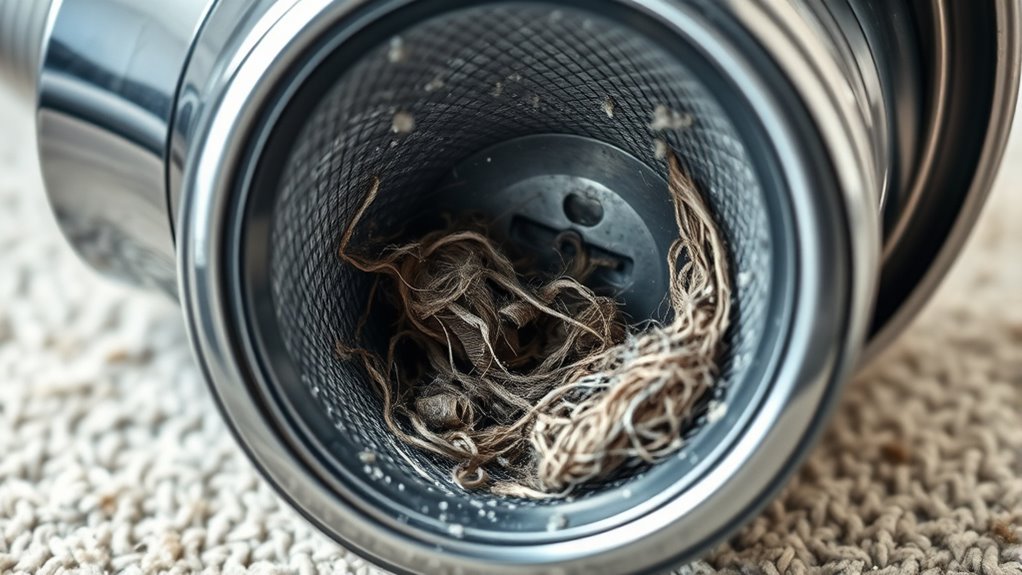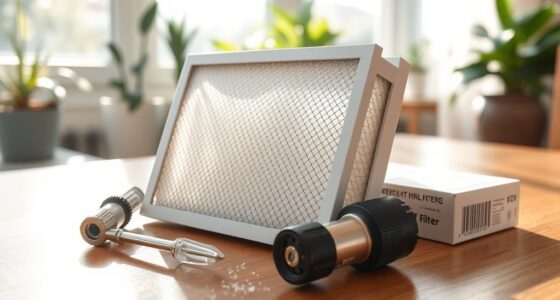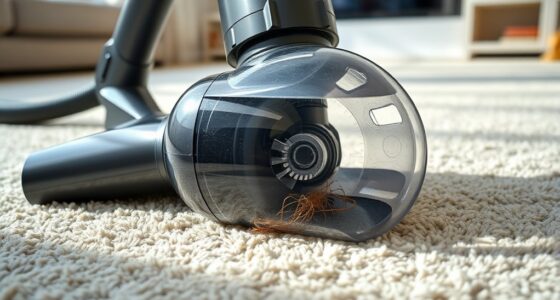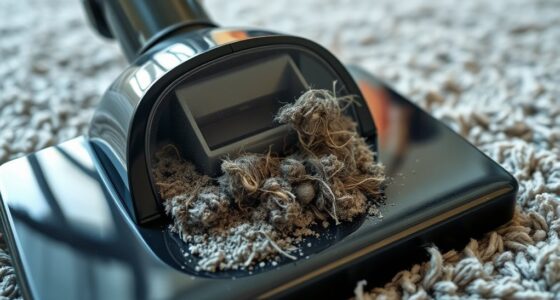To unclog your vacuum, start by turning it off and unplugging it, then inspect the hose, filters, and brush roll for debris or damage. Disassemble parts if needed and clear blockages with tools like tweezers or compressed air. Regular maintenance, such as cleaning filters and brushes, helps prevent future clogs. If stubborn blockages persist, seeking professional help might be your best bet. Keep going to discover more tips for smooth, clog-free vacuuming.
Key Takeaways
- Turn off and unplug the vacuum before inspecting or disassembling to prevent injury.
- Check hoses, filters, and brush rollers for visible debris, damage, or kinks.
- Use appropriate tools like screwdrivers and tweezers to carefully remove blockages.
- Regularly clean or replace filters and remove tangled hair or debris from brushes.
- If the clog persists or internal damage is suspected, seek professional repair assistance.
Recognizing the Signs of a Clogged Vacuum
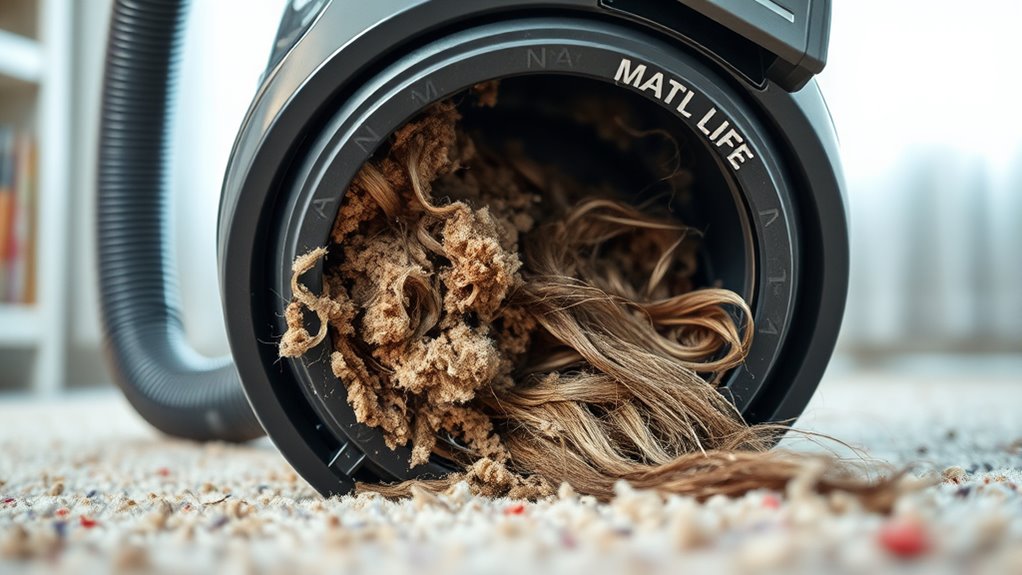
Have you noticed your vacuum isn’t performing as well as it used to? One common sign of a clog is reduced suction, which often results from hose damage or blockages. Check the hose for any visible cracks, holes, or kinks that could restrict airflow. If your vacuum is struggling to pick up debris or the brush roll isn’t spinning properly, a clog might be the culprit. Additionally, frequent filter replacement is essential; a dirty or clogged filter impairs airflow and decreases efficiency. Listen for unusual noises or increased motor strain, which can also indicate a blockage. Recognizing these signs early helps prevent further damage and ensures your vacuum works effectively. Addressing hose damage and replacing filters promptly keeps your vacuum running smoothly. Incorporating proper maintenance techniques, such as ensuring your Mazda Tuning components are optimized, can also help maintain overall device performance.
Safely Preparing to Clear the Blockage
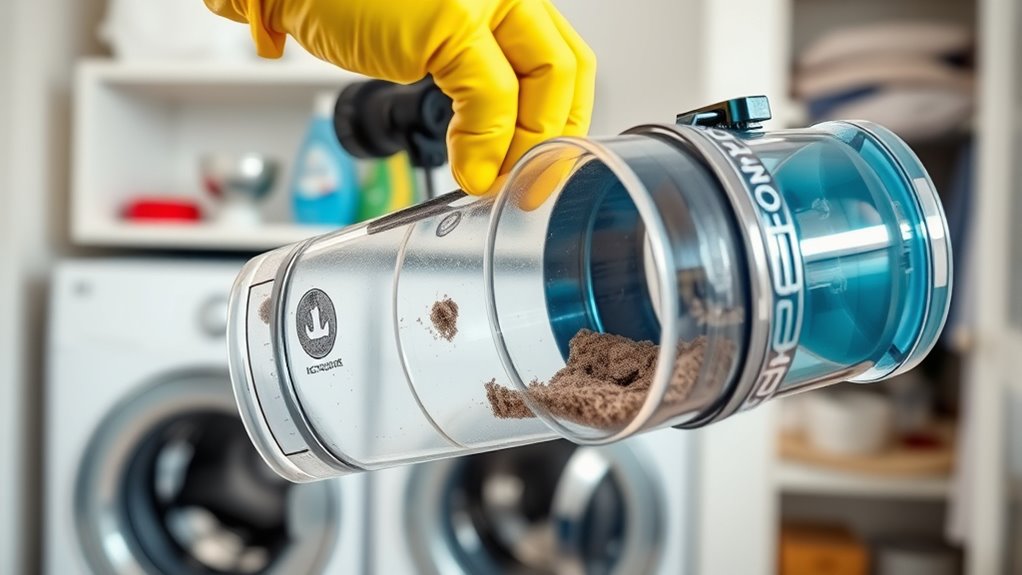
Before you start clearing a clog from your vacuum, it’s essential to turn off the device and unplug it from the power outlet. This guarantees safe handling and prevents accidental activation. Take a moment to review your vacuum’s manual for specific maintenance instructions, as different models may have unique features or safety precautions. Wear gloves to protect your hands from dirt and sharp objects. Clear nearby surfaces to create a clean workspace, which makes the process easier and safer. Disconnect the hose or remove the canister to access the blockage without risking damage or injury. Proper preparation minimizes risks and helps maintain your vacuum’s performance. You may also want to check your vacuum’s filter maintenance to ensure optimal airflow and efficiency during the process. Remember, safe handling during vacuum maintenance keeps you safe and ensures your vacuum stays in top condition.
Step-by-Step Methods to Remove Common Clogs
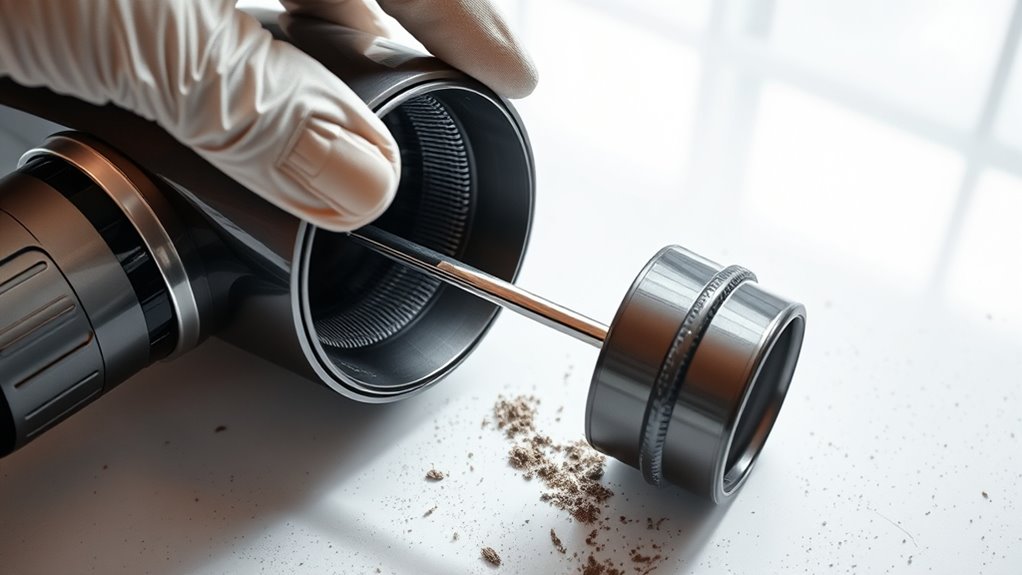
To clear common clogs, you’ll need to do it safely and effectively. Start by disassembling parts of your vacuum to gain better access to the blockage. This way, you can remove debris without damaging your machine or risking injury. Additionally, inspecting hoses for blockages or damage can prevent future clogs and maintain optimal suction performance.
Clear Blockages Safely
When a vacuum starts losing suction or makes strange noises, a clog is often the culprit. To clear blockages safely, start by turning off and unplugging your vacuum. Check the vacuum filter; if it’s dirty or clogged, clean or replace it according to the manufacturer’s instructions. Next, inspect the brush roller for tangled hair, threads, or debris that could cause blockages. Remove any obstructions carefully, ensuring the roller spins freely afterward. Avoid using sharp tools that could damage components. If you notice resistance or unusual noises during maintenance, stop immediately. Always handle parts gently and follow safety guidelines. By maintaining your vacuum filter and brush roller regularly, you prevent clogs and keep your vacuum operating at peak performance. Regular maintenance of components like vacuum filters can also help prevent common issues and prolong the lifespan of your vacuum.
Disassemble for Access
Have you ever struggled to clear a stubborn clog deep within your vacuum? Disassembling your vacuum is often necessary to reach those hidden blockages. Start by unplugging the unit and removing the brush roll cover to access the brush replacement area. Check for tangled hair or debris that could cause clogs. Next, detach the dustbin or canister to inspect for obstructions. Don’t forget to remove and clean or replace the filter; proper filter maintenance can prevent future clogs. If needed, disconnect additional hoses or attachments, carefully inspecting each for buildup. Take your time to ensure all parts are free of debris before reassembling. This step-by-step approach helps you reach the hard-to-access areas and keeps your vacuum running smoothly. Regularly maintaining your vacuum’s filter system can also help prevent future clogs and improve overall performance.
Tools and Products That Make Unclogging Easier
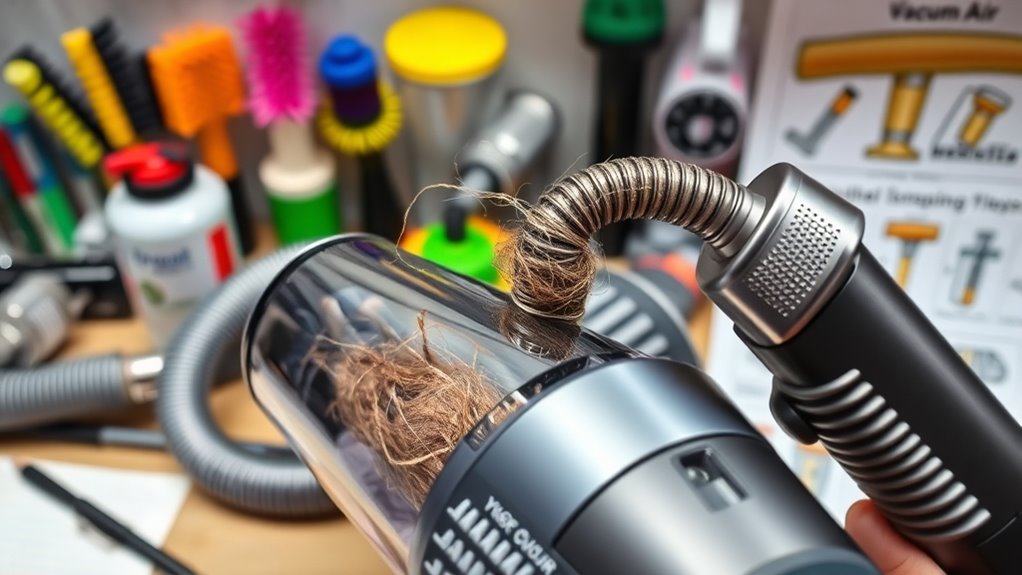
Having the right tools and products on hand can make unclogging your vacuum much easier and quicker. A sturdy screwdriver helps you disassemble parts easily, while a pair of tweezers or needle-nose pliers can remove debris stuck in tight spots. Keep a few cleaning brushes or a small shop vac to clear out dust and dirt from filters and brush rollers. Replacing or cleaning vacuum filters regularly prevents future clogs, so have spare filters ready. A flexible brush or a comb can help untangle hair or threads wrapped around the brush rollers. Using compressed air can blow out debris from hoses and vents. Proper airflow management is essential for effective vacuum performance, ensuring your machine stays unclogged and efficient. With these tools and products, you’ll streamline the process, saving time and reducing frustration during unclogging.
Preventative Measures to Keep Your Vacuum Free-Flowing
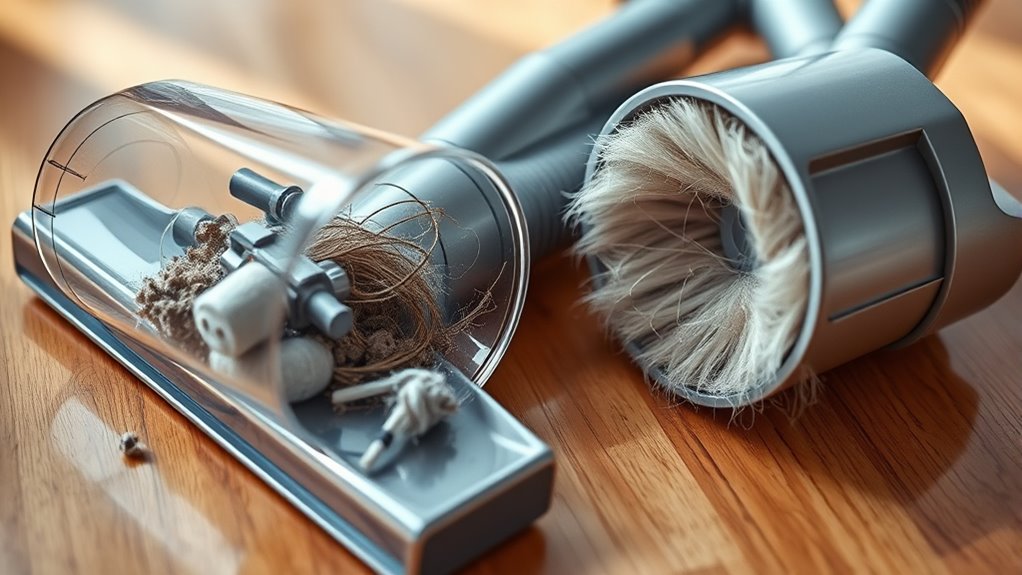
Regular maintenance is the best way to prevent clogs before they happen. Start by regularly checking and replacing your vacuum filters, as dirty filters restrict airflow and increase the risk of blockages. Clean or replace filters according to the manufacturer’s instructions to keep suction strong. Additionally, perform routine brush maintenance; clear hair, threads, and debris tangled around the brush roll to prevent obstructions that can hinder airflow. Keep your vacuum’s pathways clear by removing debris from hoses and nozzles after each use. These simple steps ensure your vacuum runs smoothly and reduces the chance of clogs forming. Consistent upkeep not only prolongs your vacuum’s lifespan but also maintains ideal cleaning performance, saving you time and effort in the long run.
When to Seek Professional Help for Stubborn Blockages
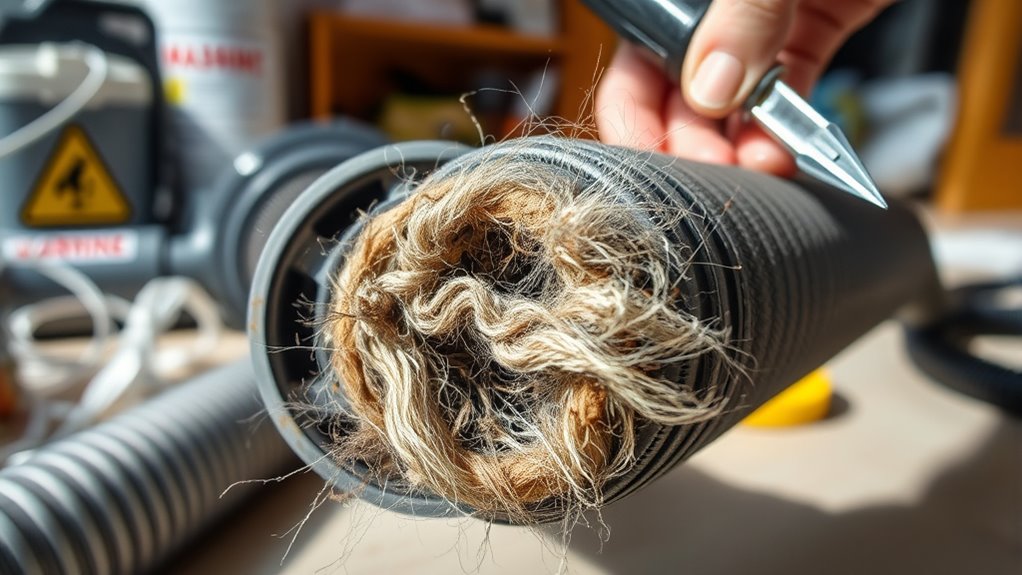
Sometimes, despite your best efforts, a stubborn vacuum blockage won’t clear with standard troubleshooting. If you notice persistent clogs that won’t budge, it’s time to seek professional assessment. Ignoring these issues can lead to further damage, which may result in costly repairs down the line. A vacuum technician has the tools and expertise to diagnose the problem accurately, whether it’s a deep-seated blockage or an internal component failure. Trying to force through the blockage yourself might worsen the situation or damage delicate parts. If your vacuum still struggles despite your efforts, don’t hesitate to call in a professional. Their assistance guarantees the problem is resolved efficiently without risking unnecessary expense or further damage to your vacuum. Additionally, understanding the importance of proper maintenance and tuning can help prevent future blockages and keep your vacuum running smoothly.
Frequently Asked Questions
Can a Clogged Vacuum Cause Permanent Motor Damage?
A clogged vacuum can indeed harm your motor and affect its lifespan if not addressed promptly. Persistent clogs cause the motor to work harder, which can lead to overheating and eventual damage. While not always permanent, this reduces motor longevity over time. Regularly checking and clearing blockages helps protect your vacuum’s motor, ensuring it runs efficiently and lasts longer. Don’t ignore clogs to maintain peak vacuum performance.
How Often Should I Check for Clogs in My Vacuum?
You should check for clogs in your vacuum every few uses, especially if you notice a decline in suction. Regular hose maintenance helps prevent blockages, so inspect the hose and attachments often. Also, don’t forget to replace filters as recommended—usually every 3-6 months—to guarantee airflow stays clear. Staying proactive keeps your vacuum working efficiently and prevents potential damage from hidden clogs.
Are There Eco-Friendly Methods to Clear Vacuum Blockages?
Ever wonder if there are eco-friendly ways to clear vacuum blockages? You can use biodegradable solutions like vinegar or baking soda to loosen debris gently. Rinse and reuse filters whenever possible to reduce waste. These methods are safer for the environment and your vacuum’s longevity. Are you ready to make your cleaning routine greener? Incorporate reusable filters and natural solutions for an eco-conscious approach that’s effective and sustainable.
What Are Common Mistakes to Avoid When Unclogging?
When unclogging your vacuum, avoid common errors like using sharp objects that can damage parts or rushing the process, which might cause damage or incomplete clearing. Follow DIY tips carefully, such as inspecting hoses thoroughly and removing debris gently. Remember, forcing parts back together or neglecting to check for blockages in all areas can lead to further issues. Be patient and methodical to guarantee a proper, damage-free fix.
How Do Different Vacuum Models Affect Clog Removal Procedures?
Imagine your vacuum as a sleek, agile swimmer maneuvering through debris. Different models, shaped by their vacuum design, influence how easily you clear clogs. Some feature advanced clog resistance, making removal smoother, while others might require more effort. Always check your vacuum’s specific instructions, as design variations impact the clog removal process—knowing this helps you act swiftly and confidently, restoring your cleaner’s flow with ease.
Conclusion
Just like finding a lost sock in a cluttered drawer, unclogging your vacuum feels satisfying when everything slides back into place. By recognizing signs early, using the right tools, and taking simple preventative steps, you keep your vacuum running smoothly. Think of it as gently guiding a stream back to its natural flow—sometimes all it takes is a little effort to restore that effortless sweep across your floors. Keep it clear, and enjoy hassle-free cleaning every time.
